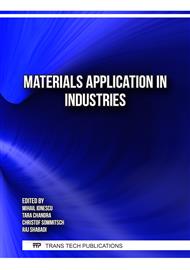[1]
X. Zhuo, Y. Wu, J. Ju et al. Recent progress of novel biodegradable zinc alloys: from the perspective of strengthening and toughening. Journal of Materials Research and Technology 2022; 17: 244-69.
DOI: 10.1016/j.jmrt.2022.01.004
Google Scholar
[2]
S. Agarwal, J. Curtin, B. Duffy et al. Biodegradable magnesium alloys for orthopaedic applications: a review on corrosion, biocompatibility and surface modifications. Materials Science and Engineering: C 2016, 68:948-963.
DOI: 10.1016/j.msec.2016.06.020
Google Scholar
[3]
E. Mostaed, M. Sikora-Jasinska, J.W. Drelich, M. Vedani. Zinc-based alloys for degradable vascular stent applications. Acta Biomaterialia 2018, 71: 1-23.
DOI: 10.1016/j.actbio.2018.03.005
Google Scholar
[4]
G. Chandra, A. Pandey. Biodegradable bone implants in orthopedic applications: a review. Biocybernetics and Biomedical Engineering 2020, 40(2):596-610.
DOI: 10.1016/j.bbe.2020.02.003
Google Scholar
[5]
B. Zhao, X. Qiu, D. Wang et al. Application of bioabsorbable screw fixation for anterior cervical decompression and bone grafting. Clinics 2016;71:320-24.
DOI: 10.6061/clinics/2016(06)06
Google Scholar
[6]
F. Witte, J. Fischer, J. Nellesen et al. In vitro and in vivo corrosion measurements of magnesium alloys. Biomaterials 2006;27:1013-18.
DOI: 10.1016/j.biomaterials.2005.07.037
Google Scholar
[7]
Y.F. Zheng, X.N. Gu, F. Witte. Biodegradable metals. Materials Science and Engineering R 2014; 77:1-34.
Google Scholar
[8]
C.J. Frederickson, J.-Y. Koh, A.I. Bush. The neurobiology of zinc in health and disease. Nature Reviews Neuroscience 2005;6:449-62.
Google Scholar
[9]
B.L. Vallee, K.H. Falchuk. The biochemical basis of zinc physiology. Physiological Reviews 1993; 73: 79-118.
DOI: 10.1152/physrev.1993.73.1.79
Google Scholar
[10]
H. Kabir, K. Munir, C. Wen et al. Recent research and progress of biodegradable zinc alloys and composites for biomedical applications: Biomechanical and biocorrosion perspectives. Bioactive Materials 2021;6(3):836-79.
DOI: 10.1016/j.bioactmat.2020.09.013
Google Scholar
[11]
D. Vojtěch, J. Kubásek, J. Šerák et al. Mechanical and corrosion properties of newly developed biodegradable Zn-based alloys for bone fixation. Acta Biomaterialia 2011; 7: 3515-22.
DOI: 10.1016/j.actbio.2011.05.008
Google Scholar
[12]
P.K. Bowen, R.J. Guillory, E.R. Shearier et al. Metallic zinc exhibits optimal biocompatibility for bioabsorbable endovascular stents. Materials Science and Engineering C 2015;56:467-72.
DOI: 10.1016/j.msec.2015.07.022
Google Scholar
[13]
B. Jia, H. Yang, Z. Zhang et al. Biodegradable Zn–Sr alloy for bone regeneration in rat femoral condyle defect model: In vitro and in vivo studies. Bioactive Materials 2021;6(6):1588-1604.
DOI: 10.1016/j.bioactmat.2020.11.007
Google Scholar
[14]
S. Du, Y. Shen, Y. Zheng et al. Systematic in vitro and in vivo study on biodegradable binary Zn-0.2 at% Rare Earth alloys (Zn-RE: Sc, Y, La–Nd, Sm–Lu). Bioactive Materials 2023;24:507-23.
DOI: 10.1016/j.bioactmat.2023.01.004
Google Scholar
[15]
K. Guruviah, S.K. Annamalai, A. Ramaswamy et al. Comparative antimicrobial and anticancer activity of biologically and chemically synthesized zinc oxide nanoparticles toward breast cancer cells. Nanomedicine Journal 2020;7(4):272-283.
Google Scholar
[16]
N.M. Al-Enazi, K. Alsamhary, M. Kha et al. In vitro anticancer and antibacterial performance of biosynthesized Ag and Ce co-doped ZnO NPs. Bioprocess and Biosystems Engineering 2023;46:89-103.
DOI: 10.1007/s00449-022-02815-8
Google Scholar
[17]
Q. Mao, Y. Liu, Y. Zhao. A review on mechanical properties and microstructure of ultrafine grained metals and alloys processed by rotary swaging. Journal of Alloys and Compounds 2022; 896: 163122.
DOI: 10.1016/j.jallcom.2021.163122
Google Scholar
[18]
L. Ye, H. Huang, C. Sun et al. Effect of grain size and volume fraction of eutectic structure on mechanical properties and corrosion behavior of as-cast Zn–Mg binary alloys, Journal of Materials Research and Technology 2022;16:1673-1685.
DOI: 10.1016/j.jmrt.2021.12.101
Google Scholar
[19]
Q. Li, M. Wei, J. Yang et al. Effect of Ca addition on the microstructure, mechanical properties and corrosion rate of degradable Zn-1Mg alloys, Journal of Alloys and Compounds 2021;887:161255.
DOI: 10.1016/j.jallcom.2021.161255
Google Scholar
[20]
ASTM G59–97(2003). Standard test method for conducting potentiodynamic polarization resistance measurements. West Conshohocken, PA: ASTM International, 2006.
Google Scholar
[21]
N. Martynenko, N. Anisimova, O. Rybalchenko et al. Effect of high-pressure torsion on microstructure, mechanical and operational properties of Zn-1%Mg-0.1%Ca alloy, Metals. 12(10) (2022) 1681.
DOI: 10.3390/met12101681
Google Scholar
[22]
K. Ren, K. Zhang, Y. Zhang et al. Effect of ECAP temperature on formation of triple heterogeneous microstructure and mechanical properties of Zn–1Cu alloy, Mater. Sci. Eng. A. 826 (2021) 141990.
DOI: 10.1016/j.msea.2021.141990
Google Scholar



